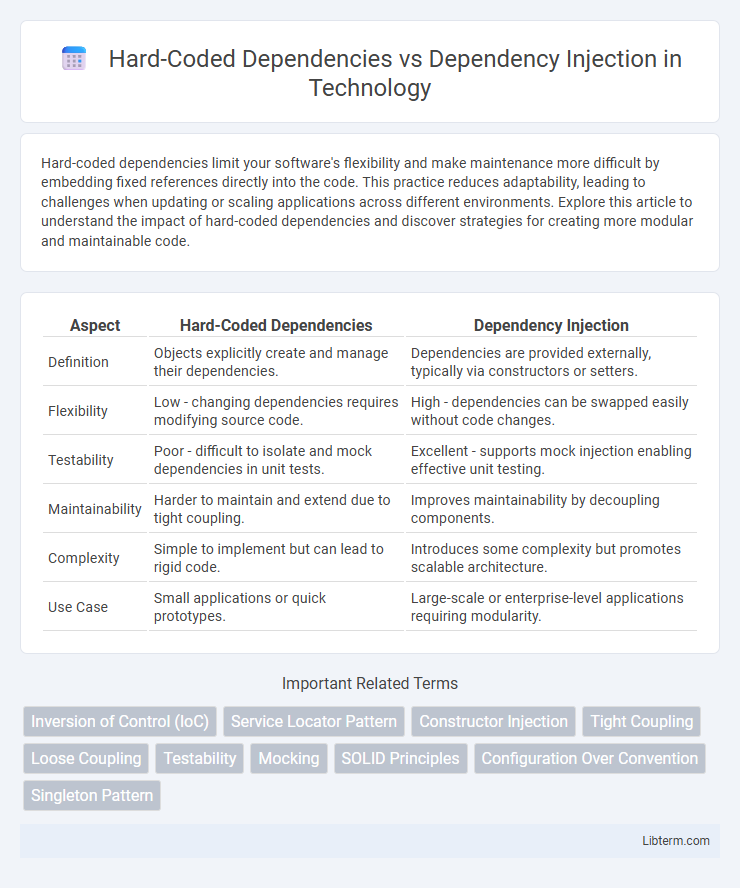Hard-coded dependencies limit your software's flexibility and make maintenance more difficult by embedding fixed references directly into the code. This practice reduces adaptability, leading to challenges when updating or scaling applications across different environments. Explore this article to understand the impact of hard-coded dependencies and discover strategies for creating more modular and maintainable code.
Table of Comparison
| Aspect | Hard-Coded Dependencies | Dependency Injection |
|---|---|---|
| Definition | Objects explicitly create and manage their dependencies. | Dependencies are provided externally, typically via constructors or setters. |
| Flexibility | Low - changing dependencies requires modifying source code. | High - dependencies can be swapped easily without code changes. |
| Testability | Poor - difficult to isolate and mock dependencies in unit tests. | Excellent - supports mock injection enabling effective unit testing. |
| Maintainability | Harder to maintain and extend due to tight coupling. | Improves maintainability by decoupling components. |
| Complexity | Simple to implement but can lead to rigid code. | Introduces some complexity but promotes scalable architecture. |
| Use Case | Small applications or quick prototypes. | Large-scale or enterprise-level applications requiring modularity. |
Introduction to Dependency Management
Hard-coded dependencies tightly couple components, making code less flexible and harder to test or maintain. Dependency Injection (DI) improves dependency management by supplying required objects externally, enhancing modularity and facilitating unit testing. Effective DI frameworks streamline object creation and lifecycle management, promoting scalable and loosely coupled application architecture.
Understanding Hard-Coded Dependencies
Hard-coded dependencies occur when a class directly instantiates its required objects, creating tight coupling and reducing code flexibility. This approach limits testability and maintainability by embedding specific implementations within the code, making it difficult to substitute or mock dependencies. Understanding hard-coded dependencies is crucial for recognizing the benefits of design patterns like Dependency Injection, which promote loose coupling and enhance modularity.
What is Dependency Injection?
Dependency Injection is a design pattern that allows the removal of hard-coded dependencies by providing objects their required dependencies externally rather than creating them internally. This approach enhances modularity, testability, and flexibility by decoupling the creation and binding of dependencies from the business logic. Frameworks like Spring for Java and Angular for TypeScript use dependency injection to manage and inject components automatically, improving maintainability and scalability of applications.
Key Differences Between Hard-Coded Dependencies and Dependency Injection
Hard-coded dependencies tightly couple components by embedding specific class instances directly within the code, limiting flexibility and testability. Dependency Injection (DI) decouples component creation from usage by externally providing dependencies, enabling easier maintenance, improved modularity, and better unit testing. Key differences include DI's support for inversion of control, enhanced scalability, and the ability to swap implementations without altering the dependent code base.
Benefits of Using Dependency Injection
Dependency Injection enhances code modularity by decoupling class dependencies, allowing easier testing and maintenance. It promotes flexibility through improved scalability and reusability of components across different parts of an application. By managing object lifecycles and configurations externally, it reduces hard-coded dependencies, leading to cleaner, more manageable codebases.
Drawbacks of Hard-Coded Dependencies
Hard-coded dependencies limit flexibility by tightly coupling components, making code difficult to modify or extend. This approach increases maintenance costs and complicates unit testing due to the inability to easily substitute or mock dependencies. Furthermore, hard-coded dependencies reduce reusability and hinder scalability in large or evolving software systems.
Common Dependency Injection Patterns
Common dependency injection patterns include constructor injection, setter injection, and interface injection, each improving modularity by decoupling hard-coded dependencies from core logic. Constructor injection is favored for mandatory dependencies, ensuring all required components are provided during object creation, while setter injection allows optional dependencies to be set post-instantiation. Interface injection involves implementing a contract to inject dependencies, promoting scalability and testability by enabling dynamic configuration of components.
Real-World Examples and Use Cases
Hard-coded dependencies, as seen in legacy monolithic applications, create tightly coupled components that hinder testing and scalability, exemplified by a payment processing module directly instantiating a gateway class. In contrast, dependency injection frameworks like Spring in Java enable flexible service swapping, demonstrated by injecting different notification services (email, SMS) without altering client code, enhancing maintainability and unit testing. Real-world use cases include enterprise web applications adopting dependency injection to support multiple database providers or third-party APIs with minimal code changes, facilitating continuous integration and deployment pipelines.
Best Practices for Implementing Dependency Injection
Implementing dependency injection (DI) enhances code maintainability, testability, and scalability by decoupling object creation from business logic, avoiding hard-coded dependencies that reduce flexibility. Best practices for DI include using constructor injection for mandatory dependencies, employing dependency inversion principles, and leveraging DI containers like Spring or Guice to automate and manage object lifecycles efficiently. Applying these techniques fosters modular architecture and simplifies unit testing by enabling easy mocking or stubbing of dependencies.
Conclusion: Choosing the Right Approach
Hard-coded dependencies simplify initial development but hinder testing and scalability due to tight coupling between components. Dependency Injection enhances modularity and testability by decoupling class dependencies, promoting maintainable and flexible codebases. Selecting the right approach depends on project complexity, testing requirements, and the need for future adaptability.
Hard-Coded Dependencies Infographic

 libterm.com
libterm.com